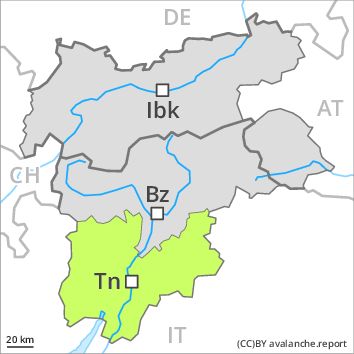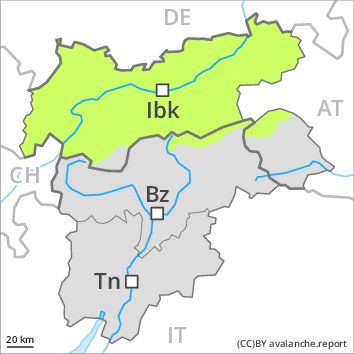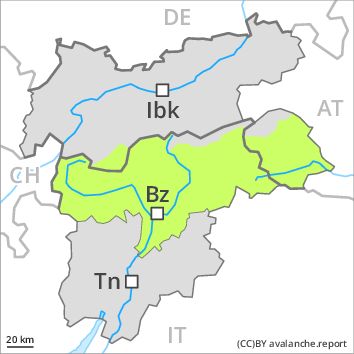Regions
Latemar, Southern Adamello, Primiero - Pale di S. Martino, Adamello - Presanella, Prealps, Northern Brenta - Peller, Cembra Valley, Bondone and Stivo, Vallarsa, Western Nonsberg Alps, Folgaria - Laverone, Southern Brenta, Fassa Valley, Sole, Pejo and Rabbi, Southern Lagorai, Ledro Valley, Northern Lagorai, Maddalene, Paganella, Marzola - Valsugana, Pine' - Mocheni Valley

Danger level
Danger Level 1 - Low

The snowpack will be quite stable. Fresh snow towards the evening. For this reason the danger will increase.
The Avalanche Warning Service currently has only a small amount of information that has been collected in the field.
The wind slabs must be evaluated with care and prudence at high altitudes and in high Alpine regions. These can in very isolated cases be released, in particular by large loads, especially on very steep shady slopes in pass areas. Mostly the avalanches are small.
Intermediate altitudes and below approximately 2200 m: As a consequence of warming during the day and solar radiation there will be only a slight increase in the danger of gliding avalanches and moist snow slides, in particular on steep sunny slopes. Gradual increase in avalanche danger as the snowfall becomes more intense. The prevalence of avalanche prone locations will increase during the course of the night.
Snowpack
Very steep shady slopes: The wind slabs are lying on soft layers. In very isolated cases weak layers exist in the old snowpack, in particular on steep shady slopes above approximately 2200 m.
East, south and west facing slopes: The wind slabs are lying on a crust. The surface of the snowpack will freeze to form a strong crust and will soften during the day.
At low altitude no snow is lying. Night: 10 to 20 cm of snow, and even more in some localities, will fall above approximately 1000 m.
Tendency
Gradual increase in avalanche danger as a consequence of the snowfall.
Regions
Weißkugel Range, Western Verwall Mountains, Central Stubai Alps, Eastern Verwall Mountains, Northern Zillertal Alps, Allgäu Alps, Silvretta, Venediger Range, Samnaun Mountains, Eastern Lechtal Alps - Ammergau Alps, Southern Zillertal Alps and High Tauern, Northern Oetz and Stubai Alps, Mieming Mountains, Western Tuxer Alps, Karwendel Mountains, Eastern Tuxer Alps, Brandenberg Alps, Western Kitzbühel Alps, Wilder Kaiser Mountains - Waidring Alps, Eastern Kitzbühel Alps, Western Lechtal Alps, Central Lechtal Alps, Glockturm Range, Grieskogel Mountains

Danger level
Danger Level 1 - Low

The snowpack will be quite stable. Fresh snow as the day progresses. For this reason the danger will increase a little.
The Avalanche Warning Service currently has only a small amount of information that has been collected in the field.
The wind slabs must be evaluated with care and prudence at high altitudes and in high Alpine regions. These can in very isolated cases be released, in particular by large loads. Mostly the avalanches are small.
Intermediate altitudes and below approximately 2200 m: As a consequence of warming during the day and solar radiation there will be only a slight increase in the danger of gliding avalanches and moist snow slides, in particular on steep sunny slopes. Gradual increase in avalanche danger as the snowfall becomes more intense. The prevalence of avalanche prone locations will increase as the day progresses.
Snowpack
Very steep shady slopes: The somewhat older wind slabs are lying on soft layers. In very isolated cases weak layers exist in the old snowpack, in particular on steep shady slopes above approximately 2200 m.
East, south and west facing slopes: The wind slabs are lying on a crust.
At low altitude no snow is lying. During the day: 10 to 20 cm of snow, and even more in some localities, will fall above approximately 1000 m.
Tendency
Gradual increase in avalanche danger as a consequence of the snowfall.
Regions
Sexten Dolomites, Val Müstair Alps, Langtaufers, Schnals Ridge, Southern Stubai Alps, Saldurn-Mastaun Ridge, Texel Mountains, Sarntal Alps, Western Pfunderer Mountains, Eastern Pfunderer Mountains, Durreck Range, Western Rieserferner Mountains, Gurgler Range, Western Deferegger Alps, Ortler Range, Ulten Valley, Eastern Nonsberger Alps, Eastern Rieserferner Mountains, Northern Dolomites of Fiemme, Glockner Range, Gröden Dolomites, Eastern Deferegger Alps, Prags Dolomites, Schober Mountains, Lienzer Dolomites

Danger level
Danger Level 1 - Low

Some snow will fall in the evening in some regions.
The Avalanche Warning Service currently has only a small amount of information that has been collected in the field.
Wet snow represents the main danger. As a consequence of warming during the day and solar radiation there will be only a slight increase in the danger of gliding avalanches and moist snow slides, in particular on steep sunny slopes.
The somewhat older wind slabs can be released, especially by large additional loads, especially on steep shady slopes above approximately 2400 m. Mostly the avalanches are small. During the night as a consequence of the snowfall there will be only a slight increase in the avalanche danger.
Snowpack
0 to 5 cm of snow, and even more in some localities, will fall in the evening. Very steep shady slopes: The wind slabs are lying on soft layers. In very isolated cases weak layers exist in the old snowpack, in particular on steep, little used shady slopes above approximately 2200 m.
At low altitude no snow is lying.
Tendency
Slight increase in avalanche danger as a consequence of the fresh snow.



